



Table of Contents
- Highlights of Samruddhi Mahamarg
- Features of Samruddhi Mahamarg
- Tourist Destinations near Samruddhi Mahamarg
- Samruddhi Mahamarg Toll Rates
- Samruddhi Mahamarg Route: Mumbai Nagpur Expressway Cost
- Samruddhi Mahamarg: Other Expressways to be Connected
- Samruddhi Mahamarg: Land Acquisition Details
- Mumbai Nagpur Expressway: Real Estate Impact
- Conclusion
- Faq's
The Samruddhi Mahamarg, also known as the Mumbai-Nagpur Expressway, is a transformative infrastructure project that is realizing Prime Minister Narendra Modi's vision of improved connectivity and economic growth in Maharashtra.
This 701-km long, access-controlled expressway is one of India's longest greenfield road projects, connecting the state's capital Mumbai with its third-largest city, Nagpur.
The project, led by the Maharashtra State Road Development Corporation (MSRDC), is being built at a cost of around ₹55,000 crore (equivalent to ₹580 billion or US$7.3 billion in 2023).
The expressway will reduce the travel time between Mumbai and Nagpur from 17 hours to just 7 hours. It will also improve connectivity to the Marathwada and Vidarbha regions, boosting the economy of 24 districts.
The Samruddhi Mahamarg is a transformative infrastructure project that will significantly improve connectivity and boost economic growth in Maharashtra. It will connect major cities, tourist destinations, and industrial hubs, while also passing through rural areas to promote development.
In this article, we will take a deeper look into the benefits that Samruddhi Mahamarg will bring, it's route, toll rates, tourist destinations on the route, project details, other expressways it connects and more.
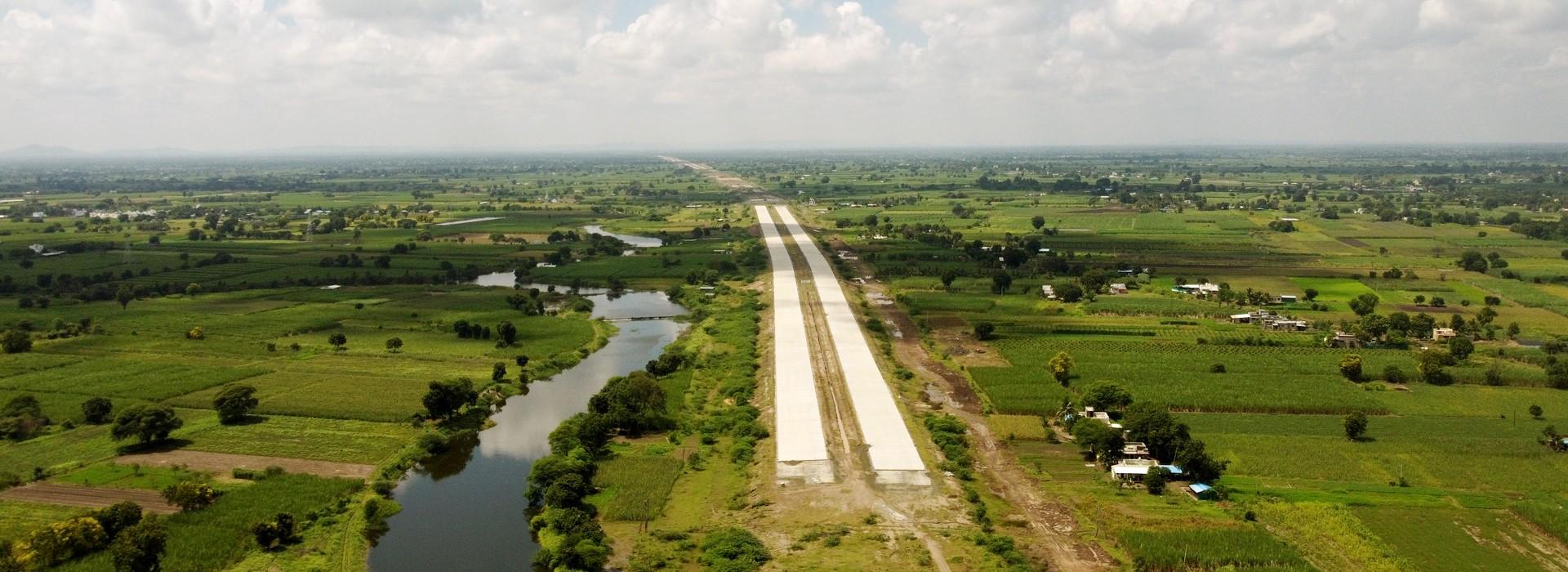 Mumbai-Nagpur expressway construction
Mumbai-Nagpur expressway constructionHighlights of Samruddhi Mahamarg
Length | 701 km |
Number of lanes | 6 lanes |
Official name | Hindu Hrudayasamrat Balasaheb Thackeray Maharashtra Samruddhi Mahamarg |
Number of villages passed | 390 |
Number of districts crossed | 10 |
Travel time reduction between Mumbai and Nagpur | From 17 hours to 7 hours |
Longest tunnel | At Kasara Ghat, Igatpuri |
Number of bigger bridges | 33 |
Number of smaller bridges | 274 |
Number of tunnels | 6 |
Number of flyovers | 65 |
Major cities on the route | Bhiwandi, Kalyan, Igatpuri, Sinnar, Shirdi, Aurangabad, Mehkar, Nagpur |
Number of wildlife sanctuaries along the route | 3 |
Number of underpasses and overpasses | Numerous |
Estimated number of vehicles per day | 30,000 to 35,000 |
Speed limit | 120 km/h on flat surfaces, 100 km/h on hilly surfaces |
Toll rates | Not finalized yet |
Total project cost | Around ₹55,000 crore (equivalent to ₹580 billion or US$7.3 billion in 2023) |
Estimated completion | December 2023 |
Features of Samruddhi Mahamarg
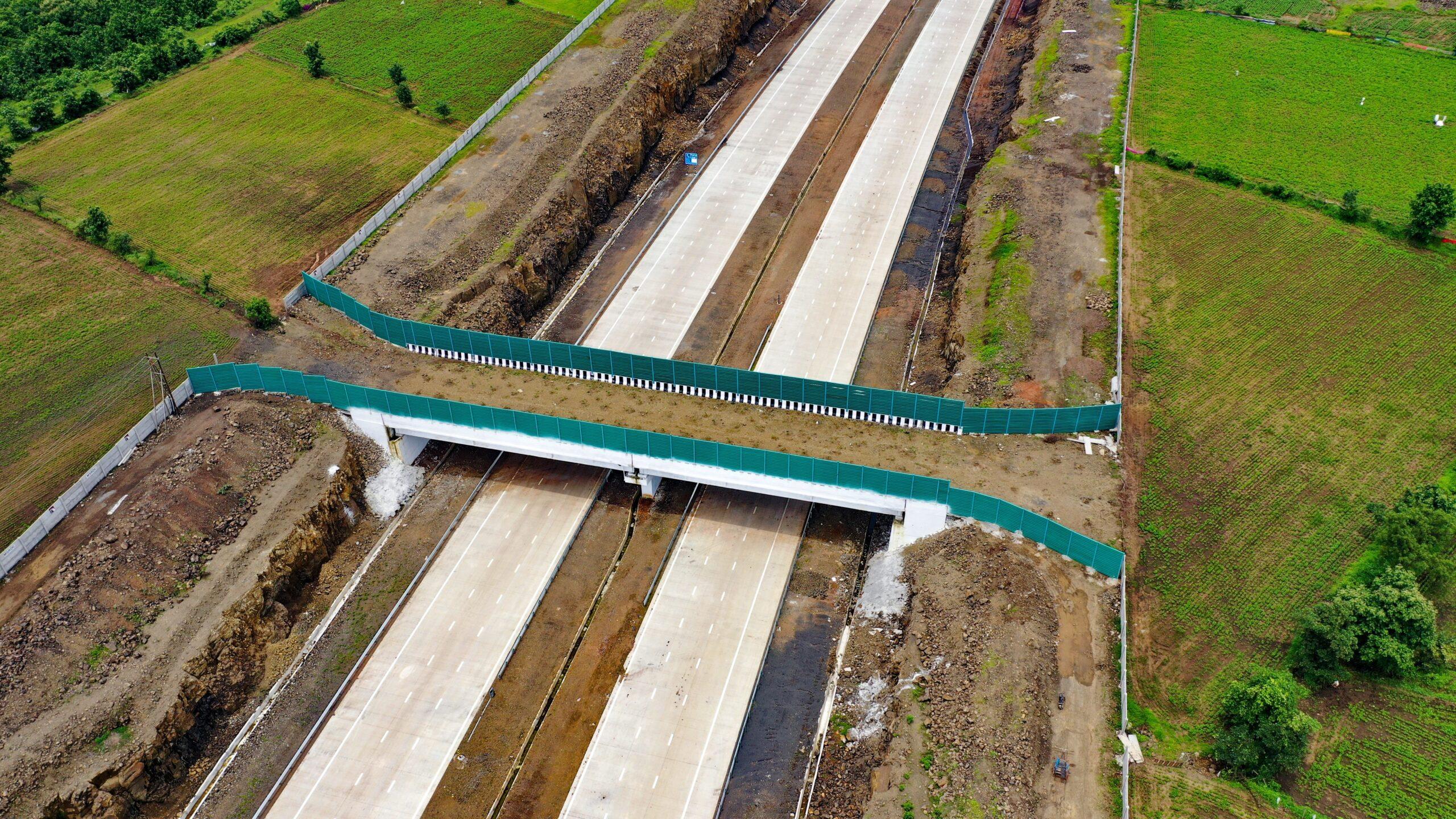 Wildlife Overpass
Wildlife Overpass
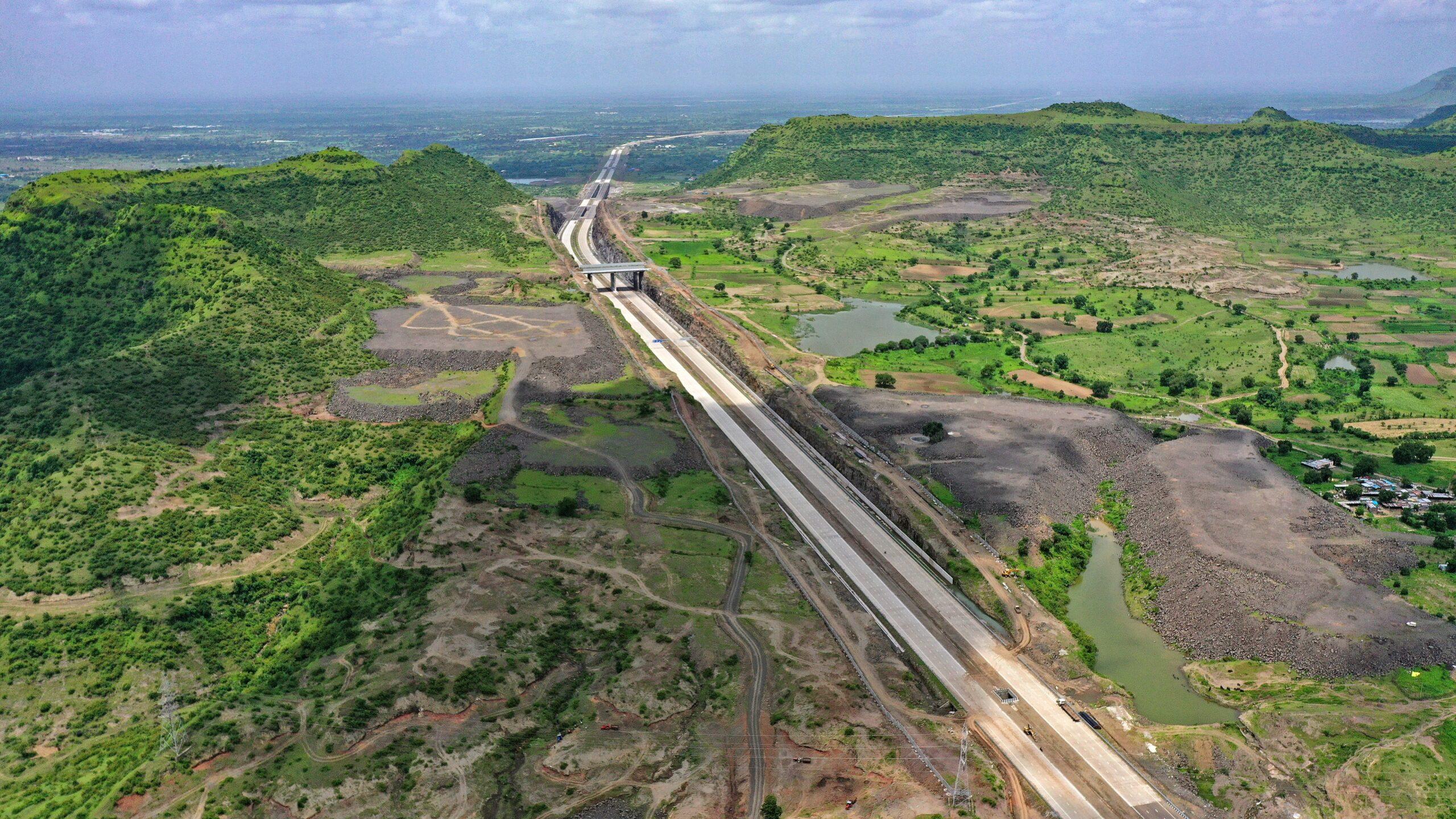
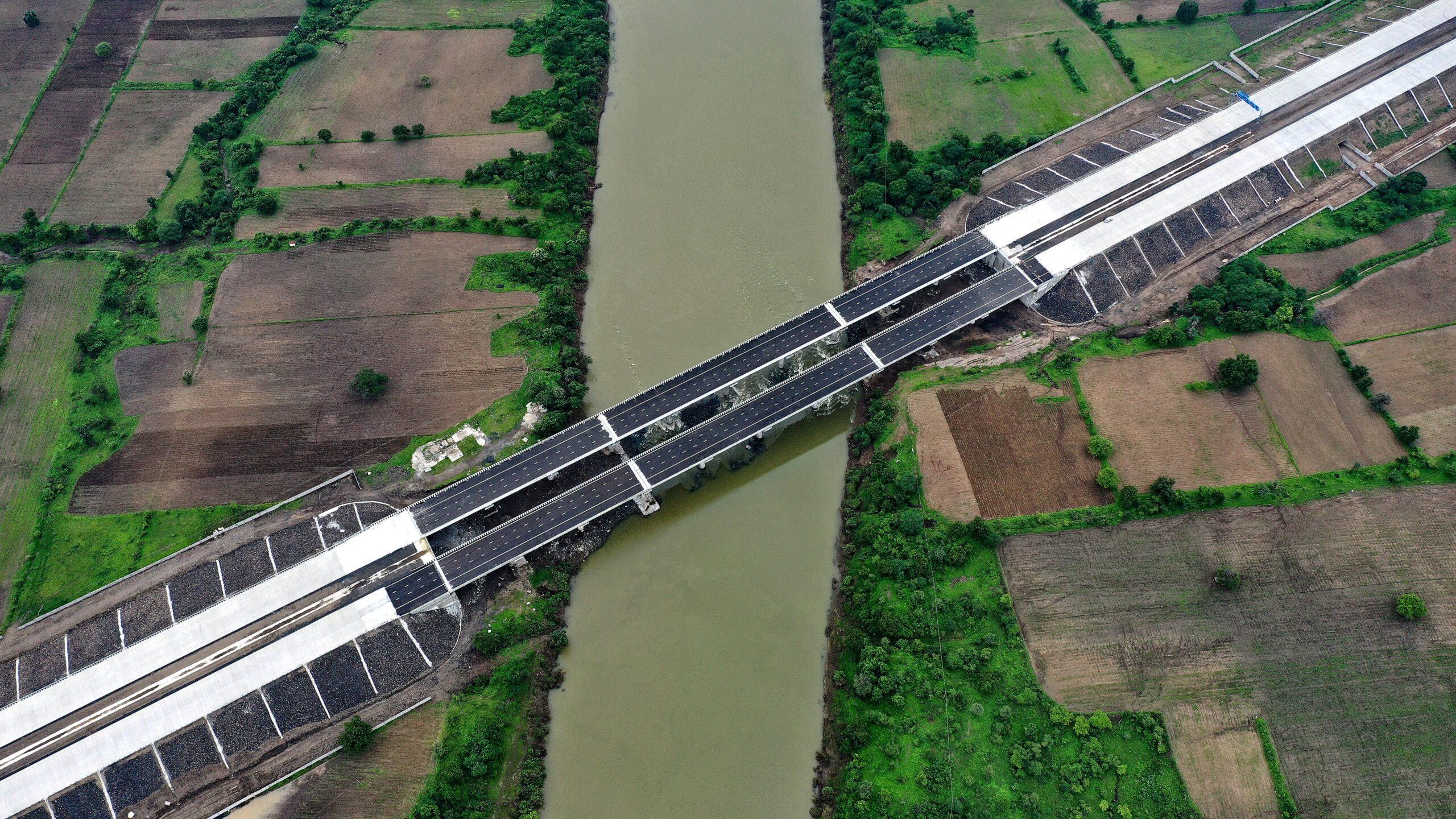 OverBridge
OverBridge
The key features of the Samruddhi Mahamarg (Mumbai-Nagpur Expressway) include:
- The expressway is a 6-lane access-controlled super communication expressway with a total width of 120 meters, including a central median of 22.5 meters. It comprises paved and unpaved shoulders on both sides.
- It features 6 tunnels, 24 interchanges, 65 flyovers/viaducts, 400+ vehicular underpasses, and 300+ pedestrian and cattle underpasses.
- In case of war-like situations, natural disasters, or emergencies, the expressway can serve as a runway for airplanes to facilitate fast incident response.
- Designed for a top speed of 120 km/hr in hilly terrain and 150 km/hr in plain terrain, making it the fastest road network in India. It aims to observe international road design and safety standards with an intelligent highway management system for traffic surveillance
- The expressway will pass through 3 wildlife sanctuaries and aims to ensure zero fatalities with free telephone booths, CCTV cameras, and wildlife mitigation measures. It will also have extensive landscaping, tunnel lighting, and bridge beautification.
- The project aims to be an energy-efficient corridor with electric vehicle charging points and solar plants planned to generate energy. It will use locally available materials, fly ash, and plastic in construction and harvest rainwater for sustainability.
These features highlight the comprehensive planning and infrastructure development of the Samruddhi Mahamarg, making it a significant project for Maharashtra's connectivity and economic growth.
Also Read: List Of Key Expressways & National Highways Connecting Delhi
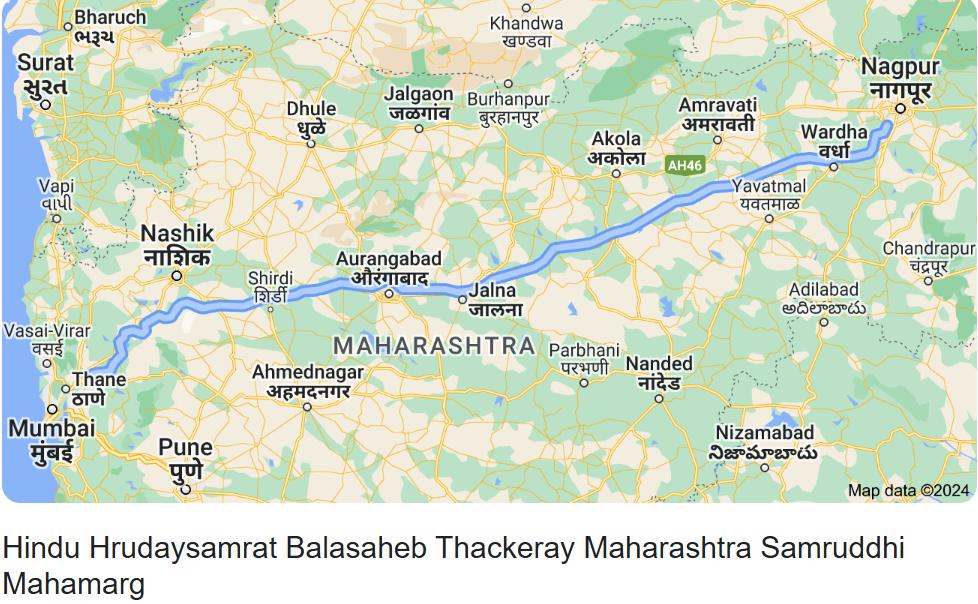
The Samruddhi Mahamarg Route officially to be known as Hindu Hrudayasamrat Balasaheb Thackeray Maharashtra Samruddhi Mahamarg will run past 390 villages and cross 10 districts in Maharashtra. Several wildlife sanctuaries are also located along the route, making it a very scenic route. There are numerous underpasses and overpasses. The Mumbai Nagpur Expressway will also feature the longest tunnel. The tunnel will be at Kasara Ghat, Igatpuri. The Samruddhi highway will pass through several major cities.
Tourist Destinations near Samruddhi Mahamarg
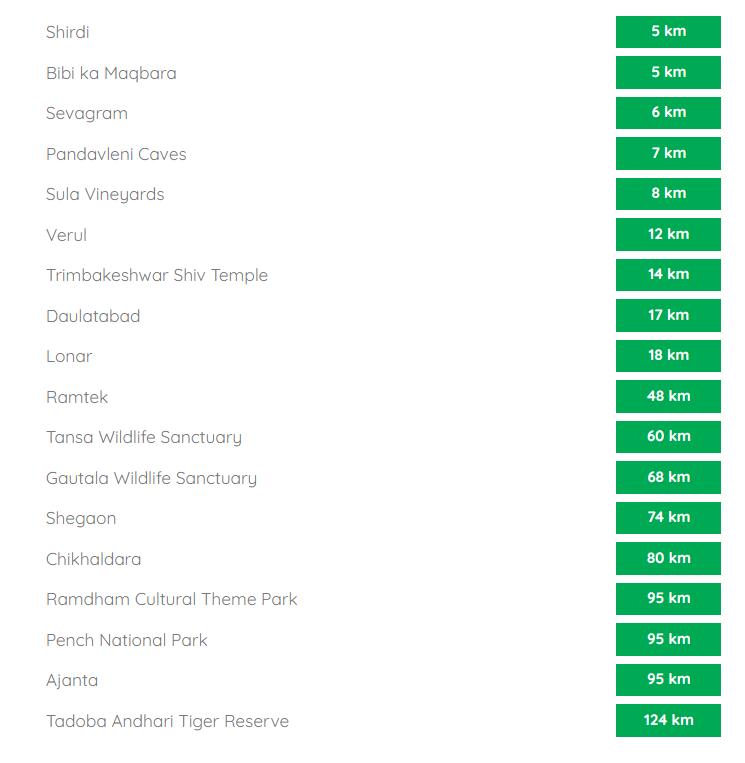 Source:
https://mahasamruddhimahamarg.com/
Source:
https://mahasamruddhimahamarg.com/
Shirdi: Located just 5 km from the expressway, Shirdi is a major pilgrimage center known for the shrine of Sai Baba.
Bibi ka Maqbara: Situated 5 km away, this monument in Aurangabad is often referred to as the "Taj of the Deccan."
Sula Vineyards: A popular winery located 8 km from the expressway, offering wine tours and tastings.
Trimbakeshwar Shiv Temple: Located 14 km away, this ancient temple dedicated to Lord Shiva is a significant pilgrimage site.
Tansa Wildlife Sanctuary: Situated 60 km from the expressway, this sanctuary is known for its diverse flora and fauna.
Pench National Park: Located 95 km away, this national park is famous for its tiger population and diverse wildlife.
Tadoba Andhari Tiger Reserve: Situated 124 km from the expressway, this reserve is one of India's premier tiger reserves.
These destinations offer a mix of cultural, religious, and natural attractions, making them ideal stops for travelers exploring the region near the Samruddhi Mahamarg.
Samruddhi Mahamarg Toll Rates
Type of Vehicle | Toll Charges per km | One-way Toll Charges between Mumbai and Nagpur |
Light Motor Vehicle (Car, Jeep) | ₹1.73 | ₹1,212 |
Light Motor Commercial Vehicle (Light goods vehicle, mini bus) | ₹2.79 | ₹1,955 |
Heavy Vehicle (two axle like Bus, truck) | ₹5.85 | ₹4,100 |
Heavy commercial vehicles (three axle vehicles) | ₹6.38 | ₹4,472 |
Heavy construction machinery | ₹9.18 | ₹6,435 |
Oversized vehicles (multi axle- seven or more axle) | ₹11.17 | ₹7,830 |
These toll rates will be applicable for the next 3 years, from 2022 to 2025.
The expressway will have 18 toll plazas between Shirdi and Nagpur alone. The total one-way toll charges for a car traveling the entire 701 km stretch from Mumbai to Nagpur is estimated to be around ₹1,200.
The toll rates have been set by the Maharashtra State Road Development Corporation (MSRDC) to recover the project cost of around ₹55,000 crore (equivalent to ₹580 billion or US$7.3 billion in 2023)
Samruddhi Mahamarg Route: Mumbai Nagpur Expressway Cost
The Samruddhi Mahamarg, also known as the Mumbai-Nagpur Expressway, is a significant infrastructure project and its cost is estimated to be around ₹55,000 crore (approximately ₹580 billion or US$7.3 billion in 2023). This amount covers the construction of the 701-kilometer six-lane expressway, which will connect Mumbai and Nagpur, passing through 10 districts and 392 villages.
The Samruddhi Mahamarg, also known as the Mumbai-Nagpur Expressway, is a significant infrastructure project in Maharashtra, India. As of December 2023, the project has made significant progress. Here are the key updates on the current status of the Samruddhi Mahamarg:
- Land Acquisition: As of May 2021, 8311.15 hectares of land (Right of Way) required for the project had been acquired, and ₹5875.93 crore had been paid.
- Environmental Clearance: All 5 Detailed Project Reports (DPRs) of the project have received environmental clearance.
- Forest Department Approval: A total of 5 DPR packages of the project have been approved by the Forest Department.
- Wildlife Conservation Department Approval: DPR Package 2 and 5 have received approval from the Wildlife Conservation Department.
- Construction Progress: Work on all 16 packages of the project is in progress, with Construction Package 1 to 13 scheduled to be completed in 30 months and Construction Package 14 to 16 in 36 months.
- Project Completion: The entire project was planned to be completed by September 2022.
- Inauguration: The Samruddhi Mahamarg was inaugurated by Prime Minister Narendra Modi on December 11, 2022.
- Phase 1: The first phase (502 km) connects Nagpur to Shirdi.
- Phase 2: The second phase (80 km) connects Shirdi and Bharvir
These updates indicate that the Samruddhi Mahamarg project is progressing as planned, with significant milestones achieved in land acquisition, environmental clearance, and construction progress.
The project's completion is expected to have a transformative impact on the connectivity and economy of Maharashtra.
The Samruddhi Mahamarg is currently under construction and is expected to be completed by 2024.
Samruddhi Mahamarg: Other Expressways to be Connected
The Samruddhi Mahamarg is not just a standalone project but part of a larger vision to enhance connectivity through a network of expressways.
Here are the details about other expressways that are planned to be connected to the Samruddhi Mahamarg based on the provided sources:
Delhi Mumbai Industrial Corridor (DMIC): The Mumbai-Nagpur Expressway, also known as the Samruddhi Mahamarg, is expected to connect to other expressways like the Delhi Mumbai Industrial Corridor (DMIC). This connectivity will further enhance transportation and trade links between major industrial hubs in the region.
Western Dedicated Freight Corridor: The Samruddhi Mahamarg is also planned to link to the Western Dedicated Freight Corridor, which is a key infrastructure project aimed at improving freight movement between the western and northern parts of India. This connection will facilitate efficient transportation of goods and boost economic activities along the corridor.
Samruddhi Mahamarg: Land Acquisition Details
The land acquisition process has faced some challenges, particularly with land registered in the name of minors, gifted land, temple land, and land belonging to the Waqf Board. The MSRDC has been working to resolve these issues through legal means and by engaging in dialogue with landowners.
Mumbai Nagpur Expressway: Real Estate Impact
The expressway is expected to have a positive impact on real estate and tourism in the areas it passes through. The improved connectivity and accessibility will make these areas more attractive to investors and tourists, leading to an increase in property prices and tourism revenue.
The real estate areas that are expected to see significant growth due to the Samruddhi Mahamarg (Mumbai-Nagpur Expressway) include:
Areas along the Expressway: Regions directly along the expressway route are likely to experience a surge in real estate demand and development due to improved connectivity and accessibility.
Thane: Thane, being a major city along the route, is expected to witness substantial growth in its real estate sector. The expressway will enhance connectivity and accessibility, making Thane an attractive location for real estate investments.
Pune: Pune, a city connected by the expressway, is anticipated to see a positive impact on its real estate market. The improved connectivity will boost demand for properties in Pune and its surrounding areas.
Aurangabad: As a key city along the route, Aurangabad is likely to experience growth in its real estate sector. The expressway will enhance connectivity to Aurangabad, making it a desirable location for real estate investments.
Nashik: Nashik, another city connected by the expressway, is expected to benefit from increased real estate activity. The improved connectivity will attract investors and homebuyers to Nashik and its vicinity.
Ahmednagar: Ahmednagar, a city along the route, is poised to see growth in its real estate market. The expressway will improve accessibility to Ahmednagar, driving demand for properties in the area.
Jalna: Jalna, a town along the expressway, is likely to witness real estate development and growth. The enhanced connectivity will make Jalna an attractive location for real estate investments.
These areas are expected to see significant growth in their real estate sectors as a result of the improved connectivity and economic development brought about by the Samruddhi Mahamarg project.
Conclusion
In conclusion, the Samruddhi Mahamarg is a game-changer for Maharashtra, not only in terms of transportation but also in its potential to drive economic growth, create jobs, and improve the overall quality of life for the people of the state. As the project progresses, it will undoubtedly leave a lasting impact on the region and serve as a model for future infrastructure development in India.
explore further
Latest from Editorials
More from Publications
Resources
Dwello, for every home buyer, is a way to go from 'I feel' to 'I know', at no extra cost.




